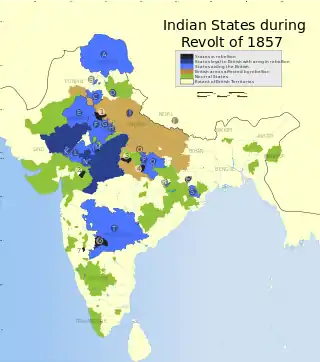List of Indian Mutiny Victoria Cross recipients
The Victoria Cross (VC) was awarded to 182 members of the British Armed Forces, British Indian Army and civilians under their command, during the Indian Mutiny (also known as the Indian Rebellion of 1857). The VC is a military decoration awarded for valour "in the face of the enemy" to members of armed forces of some Commonwealth countries and previous British Empire territories. It takes precedence over all other Orders, decorations and medals. It may be awarded to a person of any rank in any service and to civilians under military command. The VC is traditionally presented to the recipient by the British monarch during an investiture at Buckingham Palace, though in a large number of cases this was not possible and it was presented in the field by a prominent civil or military official. The VC was introduced in Great Britain on 29 January 1856 by Queen Victoria to reward acts of valour during the Crimean War.[1]

The Indian Mutiny (also known as India's First War of Independence, Revolt of 1857, or the Sepoy Mutiny) began as a mutiny of sepoys of British East India Company's army on 10 May 1857, in the town of Meerut. It soon erupted into other mutinies and civilian rebellions largely in the upper Gangetic plain and central India, with the major hostilities confined to present-day Uttar Pradesh, Bihar, northern Madhya Pradesh, and the Delhi region.[2] The rebellion posed a considerable threat to Company power in that region,[3] and it was contained only with the fall of Gwalior on 20 June 1858.[2] The rebellion proved to be an important watershed in Indian history; it led to the dissolution of the East India Company in 1858, and forced the British to reorganise the army, the financial system, and the administration in India.[4] India was thereafter governed directly from London—by the British government India Office and a cabinet level Secretary of State for India—in the new British Raj, a system of governance that lasted until 1947.
Indian troops were not originally eligible for the VC, because since 1837 they had been eligible for the Indian Order of Merit—the oldest British gallantry award for general issue. When the VC was created, Indian troops were still controlled by the Honourable East India Company, and did not come under Crown control until 1860. European officers and men serving with the Honourable East India Company were not eligible for the Indian Order of Merit; the VC was extended to cover them in October 1857. The first citations of the VC varied in the details of each action; some specify one date, some date ranges, some the name of the battle and others have both sets of information. There were only two posthumous recipients of the VC for actions during the rebellion; the original Royal Warrant did not contain a specific clause regarding posthumous awards, although official policy was to not award the VC posthumously. Between 1897 and 1901, several notices were issued in the London Gazette regarding soldiers who would have been awarded the VC had they survived. In a partial reversal of policy in 1902, six of the soldiers mentioned were granted the VC, but not "officially" awarded the medal. In 1907, the posthumous policy was completely reversed and medals were sent to the next of kin of the six officers and men; Everard Phillipps and Edward Spence were decorated thus.[5] The Victoria Cross warrant was not officially amended to explicitly allow posthumous awards until 1920.[6][7] The Indian Mutiny holds the record for the most VCs won in a single day; 24 at the Second Relief of Lucknow on 16 November 1857.[8]
Recipients
References
- General
- "Victoria Cross Registers". National Archives (UK). Retrieved 11 April 2008.
- "Honourable East India Company and Indian Army holders of the Victoria Cross". VictoriaCross.org. Retrieved 11 April 2008.
- Ashcroft, Michael (2006). Victoria Cross Heroes. Headline Book Publishing. ISBN 0-7553-1632-0.
- Bandyopadhyay, Sekhar (2004). From Plassey to Partition: A History of Modern India. New Delhi and London: Orient Longmans. ISBN 81-250-2596-0.
- Bayly, C. A. (1990). Indian Society and the Making of the British Empire (The New Cambridge History of India). Cambridge and London: Cambridge University Press. ISBN 0-521-38650-0.
- Bose, Sugata; Jalal, Ayesha (2003). Modern South Asia: History, Culture, Political Economy. London and New York: Routledge. ISBN 0-415-30787-2.
- Crook, M.J. (1975). The Evolution of the Victoria Cross. Midas books. ISBN 0-85936-041-5.
- Specific
- Ashcroft, M; 2006; preface; XI–XIII
- Bandyopadhyay, Sekhar; 2004; pp.169–172
Bose, Jalal; 2003; pp.88–103; Quote: "The 1857 rebellion was by and large confined to northern Indian Gangetic Plain and central India." - Bayly, C.A.; 1990; p.170; Quote: "What distinguished the events of 1857 was their scale and the fact that for a short time they posed a military threat to British dominance in the Ganges Plain."
- Bayly, C.A.; 1990; pp.194–197
- "No. 27986". The London Gazette. 15 January 1907. p. 325.
- Crook, MJ, Chapter 8 pp.68–90
- "No. 31946". The London Gazette. 18 June 1920. p. 6702.
- Arthur, Max; p. XIV
- "Robert Aitken details". National Archives. Retrieved 20 August 2008.
- "No. 22154". The London Gazette. 18 June 1858. p. 2957.
- "No. 22318". The London Gazette. 21 November 1859. p. 3792.
- "No. 22396". The London Gazette. 19 June 1860. p. 2316.
- "No. 22347". The London Gazette. 20 January 1860. p. 178.
- Probyn was awarded his VC for numerous gallant acts throughout the period of the Indian Rebellion of 1857.
"No. 22154". The London Gazette. 18 June 1858. p. 2960. - The 'siege' mentioned in the citation is not identified and is often wrongly assumed to be Lucknow. He served at Delhi where he was badly wounded in September 1857.
- "No. 22485". The London Gazette. 1 March 1861. p. 1007.
- "No. 22318". The London Gazette. 21 October 1859. p. 3793.
- Leek,Alan; (2018):"Frederick Whirlpool VC"; Big Sky Pub;pp 140